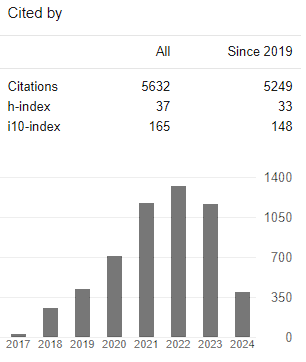Neuro-Pedagogy of the visual arts in reading comprehension
Keywords:
Neuropedagogy, reading comprehension, visual artsAbstract
The research, titled "Neuropedagogy of the Visual Arts in Reading Comprehension," sought to investigate and gather answers to the problems posed and seek to resolve methodological issues. In this context, the research adopted a qualitative and quantitative approach. The methodology used was linked to the inductive and deductive method; at the same time, a correlational and experimental research level were determined. For this purpose, the population consisted of teachers and students from the following institutions: "Oswaldo Castro" Educational Unit, "Raymundo Aveiga" Educational Unit, and "Gonzalo Abad" Educational Unit in the city of Chone, Manabí province. The sample consisted of a total of 60 students; 20 students from each institution. In the data collected during the research, based on the use of strategies based on the neuropedagogy of the visual arts, the objective was to identify and capture, through drawings, the roles of the different characters in the aforementioned excerpt from the novel. At the same time, when calculating the average grades of the experimental group, the following scores were obtained: "Oswaldo Castro" Educational Unit 5.0, "Raymundo Aveiga" Educational Unit 5.3 and "Gonzalo Abad" Educational Unit 5.7, which showed that there was a significant difference between groups when evaluating the exercise.
Downloads
References
Alcaide, M. D. D. (2011). On education in the plastic and visual arts. Space and Time: Journal of Human Sciences, (25), 163-170.
Bejarano Reinoso, Y. M. (2021). Pedagogical strategies in the visual arts to strengthen interculturality in children in basic general education at the Riobamba educational unit (Master's thesis, Riobamba, National University of Chimborazo).
Camacho, O. T., & Robles, M. A. G. (2024). The symbolic construction that students in the teaching career have about neuropedagogy in their professional training.Voices of Education, 9(17), 169-193.
Castillo, D. (2023). Neuroleadership for smart decision-making in the university context. I try, 2(1), 15-26.
Delgado, P., Vargas, C., Ackerman, R., & Salmerón, L. (2018). Don't throw away your printed books: A meta-analysis on the effects of reading media on reading comprehension. Educational research review, 25, 23-38. https://doi.org/10.1016/j.edurev.2018.09.003
Díaz, C. P. (2022). Neuropedagogy for multicultural classrooms: neuromethodology for inclusion. MLS Inclusion and Society Journal, 2(2).
Gardner, H. (1995). Multiple Intelligences. Theory in Practice. United States: PAIDÓS.
Gorodokin, I. (2005). Teacher training and its relationship with epistemology. Ibero-American Journal of Education, 37(5), 5.
Handayani, N. D., Mantra, I. B. N., & Suwandi, I. N. (2019). Integrating collaborative learning in cyclic learning sessions to promote students’ reading comprehension and critical thinking. International Research Journal of Management, IT and Social Sciences, 6(5), 303–308. https://doi.org/10.21744/irjmis.v6n5.777
Lamus de Rodriguez , T. M. , Moreira-Choez , J. S. , & Lamus-Garcia , R. Z. (2023). Influence of neuroleadership on the educational management of the UNEFM language department. UISRAEL Scientific Journal, 10(3), 37-56.
Loor, Y. E. Q., & Tuárez, L. K. C. (2023). The visual arts as enhancers of creative thinking in high school students in the 13D07 circuit of the Chone canton. Mastery of Science, 9(2), 1813-1831.
Martínez, R. P., & Lozada, D. A. T. (2022). Visual arts in education for the development of creativity.593 Digital Publisher CEIT, 7(1), 75-93.
Moghadam, S. H., Zainal, Z., & Ghaderpour, M. (2012). A review on the important role of vocabulary knowledge in reading comprehension performance. Procedia-Social and Behavioral Sciences, 66, 555-563. https://doi.org/10.1016/j.sbspro.2012.11.300
Montoya, L. M. S., Pilay, P. F. T., Zerna, R. K. S., & Hinojoza, J. E. S. (2024). Neuropedagogy and stimulation of the development of socio-emotional skills in technical careers. Teacher and Society, 21(4), 2243-2253.
Noro, J. (2018). New Philosophy and Anthropology for the Education of the Present and the Future. Digital version.https://www.academia.edu/38046498/143_FILOSOFIA_UNA_NUEVA_ANTROPOLOGIA_PARA_UNA_NUEVA_EDUCACION
Rivadeneira-Paz, G. M., Solórzano.-Macías, S. L., Solórzano-Carvajal, F. A., & Vera-Ramos, R. E. (2024). The Quality of Reading and Learning in Basic General Education Students: Case Study. International Journal of Linguistics, Literature and Culture, 10(3), 29-38.
Ulger, K. (2016). The creative training in the visual arts education. Thinking Skills and Creativity, 19, 73-87. https://doi.org/10.1016/j.tsc.2015.10.007
Vasilachis, I., Ameigeiras, A., Chernobilsky, L., Béliveau, V., & Gialdino, M. (2019). Qualitative Research Strategies. Barcelona: Gedisa.
Venanzetti, C. D., & Baez, M. O. (2024). The object of teaching initial literacy in Primary Education schools, a field of controversies and disputes. Educar em Revista, 40.
Venanzetti, C. D., & Baez, M. O. (2024). The object of teaching initial literacy in Primary Education schools, a field of controversies and disputes. Educar em Revista, 40.
Vygotsky, L. (1997). Thought and Language. Buenos Aires: La Pléyade.
Published
How to Cite
Issue
Section
Copyright (c) 2025 International research journal of management, IT and social sciences

This work is licensed under a Creative Commons Attribution-NonCommercial-NoDerivatives 4.0 International License.
Articles published in the International Research Journal of Management, IT and Social sciences (IRJMIS) are available under Creative Commons Attribution Non-Commercial No Derivatives Licence (CC BY-NC-ND 4.0). Authors retain copyright in their work and grant IRJMIS right of first publication under CC BY-NC-ND 4.0. Users have the right to read, download, copy, distribute, print, search, or link to the full texts of articles in this journal, and to use them for any other lawful purpose.
Articles published in IRJMIS can be copied, communicated and shared in their published form for non-commercial purposes provided full attribution is given to the author and the journal. Authors are able to enter into separate, additional contractual arrangements for the non-exclusive distribution of the journal's published version of the work (e.g., post it to an institutional repository or publish it in a book), with an acknowledgment of its initial publication in this journal.
This copyright notice applies to articles published in IRJMIS volumes 7 onwards. Please read about the copyright notices for previous volumes under Journal History.

















